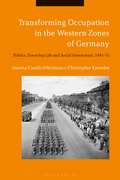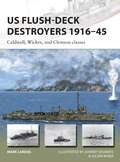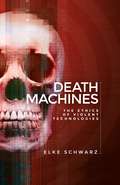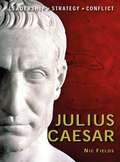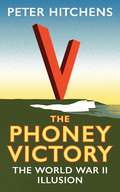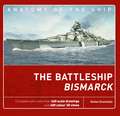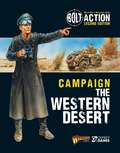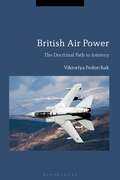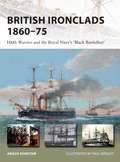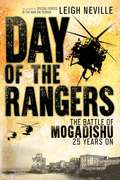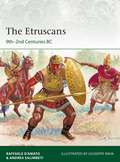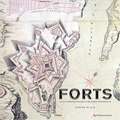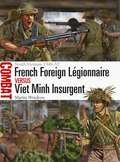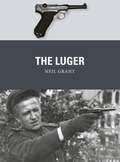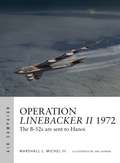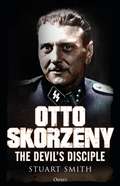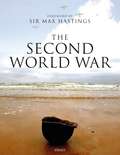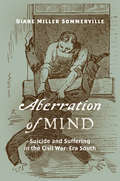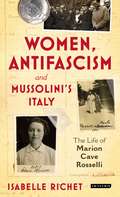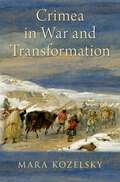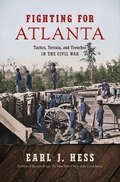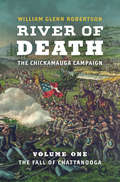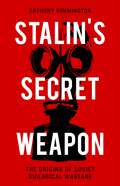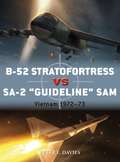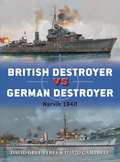- Table View
- List View
Transforming Occupation in the Western Zones of Germany: Politics, Everyday Life and Social Interactions, 1945-55
by Camilo Erlichman Christopher KnowlesTransforming Occupation in the Western Zones of Germany provides an in-depth transnational study of power politics, daily life, and social interactions in the Western Zones of occupied Germany during the aftermath of the Second World War. Combining a history from below with a top-down perspective, the volume explores the origins, impacts, and legacies of the occupations of the western zones of Germany by the United States, Britain and France, examining complex yet topical issues that often arise as a consequence of war including regime change, transitional justice, everyday life under occupation, the role of intermediaries, and the multifaceted relationship between occupiers and occupied. Adopting a novel set of approaches that puts questions of power, social relations, gender, race, and the environment centre stage, it moves beyond existing narratives to place the occupation within a broader framework of continuity and change in post-war western Europe. Incorporating essays from 16 international scholars, this volume provides a substantial contribution to the emerging fields of occupation studies and the comparative history of post-war Europe.
US Flush-Deck Destroyers 1916–45: Caldwell, Wickes, and Clemson classes (New Vanguard #259)
by Johnny Shumate Mark Lardas Julian BakerFour pipes and flush decks – these ships were a distinctively American destroyer design. Devised immediately prior to and during the United States' involvement in World War I they dominated the US Navy's destroyer forces all the way through to World War II. They were deployed on North Atlantic and Norwegian Sea convoys, and virtually everywhere in the Pacific, from Alaska to Australia. Fifty were given to Great Britain in its hour of need in 1940, and many would serve in other navies, fighting under the Soviet, Canadian, Norwegian, and even the Imperial Japanese flags. They also served in a variety of roles becoming seaplane tenders, high-speed transports, minesweepers and minelayers. One was even used as a self-propelled mine during Operation Chariot, destroying the dry dock at St. Nazaire.Fully illustrated throughout with commissioned artwork and contemporary photographs, this volume reveals the operational history of these US Navy ships that fought with distinction in both World Wars.
Death machines: The ethics of violent technologies
by Elke SchwarzDeath Machines offers a critical reconsideration of ethical theories and political justifications for technologised practices of violence in contemporary conflicts.
Julius Caesar (Command)
by Peter Dennis Nic FieldsOne of the greatest military commanders in history, Julius Caesar's most famous victory – the conquest of Gaul – was to him little more than a stepping stone to power. An audacious and decisive general, his victories over the Gauls allowed him to challenge for the political leadership of Rome. Leading a single legion across the Rubicon in 49 BC, Caesar launched a civil war which would end the Roman Republic and usher in the Roman Empire, with Caesar at its helm. This examination of the great general's life covers his great victories and few defeats, looking at the factors which lay behind his military genius.
The Phoney Victory: The World War II Illusion
by Peter HitchensWas World War II really the `Good War'? In the years since the declaration of peace in 1945 many myths have sprung up around the conflict in the victorious nations. In this book, Peter Hitchens deconstructs the many fables which have become associated with the narrative of the `Good War'. Whilst not criticising or doubting the need for war against Nazi Germany at some stage, Hitchens does query whether September 1939 was the right moment, or the independence of Poland the right issue. He points out that in the summer of 1939 Britain and France were wholly unprepared for a major European war and that this quickly became apparent in the conflict that ensued. He also rejects the retroactive claim that Britain went to war in 1939 to save the Jewish population of Europe. On the contrary, the beginning and intensification of war made it easier for Germany to begin the policy of mass murder in secret as well as closing most escape routes. In a provocative, but deeply-researched book, Hitchens questions the most common assumptions surrounding World War II, turning on its head the myth of Britain's role in a `Good War'.
The Battleship Bismarck (Anatomy of The Ship #1)
by Stefan DraminskiThe Bismarck is perhaps the most famous – and notorious - warship ever built. Completed in 1941, the 45,000-ton German battleship sunk HMS Hood, the pride of the British Navy, during one of the most sensational encounters in naval history. Following the sinking, Bismarck was chased around the North Atlantic by many units of the Royal Navy. She was finally dispatched with gunfire and torpedoes on 27 May, less than five months after her completion. Her wreck still lies where she sank, 4,800m down and 960km off the west coast of France. Drawing on new research and technology, this edition is the most comprehensive examination of Bismarck ever published. It includes a complete set of detailed line drawings with fully descriptive keys and full-colour 3D artwork, supported by technical details, photographs and text on the building of the ship and a record of the ship's service history.
Bolt Action: The Western Desert (Bolt Action)
by Warlord Games Peter DennisOne of the most popular and enduring campaigns of World War II is that of the Western Desert, where Allied armies beat back the hard-pressed German and Italian forces under the gruelling African sun. Covering crucial operations such as Crusader, Lightfoot, and Supercharge, and the great battles of Tobruk, El Alamein, and Gazala, this book brings the unforgiving battlefields of North Africa to the tabletop. In-depth information on the forces involved, linked scenarios, and new Theatre Selectors make this an ideal resource for any Bolt Action player with an interest in the Desert War.
British Air Power: The Doctrinal Path to Jointery
by Viktoriya FedorchakBritish Air Power demonstrates how the Royal Air Force sought to adapt in regard to the roles it could play and the conflicts in which it could be used, as well as the evolution of air power doctrine at a time of rapid changes in national politics and in the international arena. The development of new concepts and theories, the evaluation of operational experience, the political environment and budgetary cuts, and the role of academics and personalities in development of doctrine are thus all explored to show changes in strategic thinking regarding air power.Fedorchak further examines the influence of jointery – the process of co-operation between the army, navy and air force – on thinking, conceptualising, teaching and using air power in recent operations in Afghanistan, Iraq, Libya and Syria. A contemporary complement to more historical studies, British Air Power provides a very detailed look at the development of air-land doctrine in the RAF since the turn of the century.
British Ironclads 1860–75: HMS Warrior and the Royal Navy's 'Black Battlefleet' (New Vanguard)
by Paul Wright Angus KonstamIn November 1859, the French warship La Gloire was launched. She was the world's first seagoing ironclad - a warship built from wood, but whose hull was clad in a protective layer of iron plate. Britain, not to be outdone, launched her own ironclad the following year - HMS Warrior - which, when she entered service, became the most powerful warship in the world. Just like the Dreadnought half a century later, this ship changed the nature of naval warfare forever, and sparked a frantic arms race. The elegant but powerful Warrior embodied the technological advances of the early Victorian era, and the spirit of this new age of steam, iron and firepower. Fully illustrated with detailed cutaway artwork, this book covers the British ironclad from its inception and emergence in 1860, to 1875, a watershed year, which saw the building of a new generation of recognisably modern turreted battleships.
Day of the Rangers: The Battle of Mogadishu 25 Years On
by Leigh NevilleOn October 3, 1993, Task Force Ranger was dispatched to seize two high-profile lieutenants of a Somali warlord. Special Forces troops were transported by ground vehicles and helicopters, and the mission was meant to be over within the hour. They quickly found themselves under heavy fire, and two Black Hawk helicopters were shot down. With a hastily organized relief column many hours away, the American troops faced a desperate battle for survival.Focusing on the stories of the soldiers on the ground, and in the air, Day of the Rangers reveals the experiences and recollections of the Special Forces units, including the Rangers, Delta operators and Nightstalker crews who fought in the battle of Mogadishu. Published to mark the battle's 25th anniversary and using recently declassified documents and new interviews with many of the participants, Day of the Rangers is a fascinating and revealing new history of a battle that would influence American Special Forces for decades to come.
The Etruscans: 9th–2nd Centuries BC (Elite)
by Giuseppe Rava Andrea Salimbeti Raffaele D’AmatoAncient Rome had deep roots in the 'Villanovan' culture that we call today the Etruscans. Their long-lived civilization can be traced to 900–750 BC in north-west Italy. They were a sea-faring people trading with and competing against Greek and Phoenician peoples, including the Carthaginians. They were also a great land-based power, especially in the 'Classical' period, where they expanded their power north into the Po Valley and south to Latium. In the 6th century BC an Etruscan dynasty ruled Rome, and their power extended southwards to the Amalfi coast. In 509 BC the Romans rose up to expel their kings, which began the long 'Etruscan twilight' when their power was squeezed by the Samnites and, most especially, the Romans. Drawing on archaeological evidence including warrior tombs, paintings, sculptures, and fully illustrated throughout, this study examines one of the early rivals to Ancient Rome.
Forts: An illustrated history of building for defence
by The National ArchivesEver since humans began to live together in settlements they have felt the need to organise some kind of defence against potentially hostile neighbours. Many of the earliest city states were built as walled towns, and during the medieval era, stone castles were built both as symbols of the defenders' strength and as protection against potential attack. The advent of cannon prompted fortifications to become lower, denser and more complex, and the forts of the eighteenth and nineteenth centuries could appear like snowflakes in their complexity and beautiful geometry. Without forts, the history of America could have taken a very different course, pirates could have sailed the seas unchecked, and Britain itself could have been successfully invaded. This book explains the history of human fortifications, and is beautifully illustrated using photographs, plans, drawings and maps to explain why they were built, their various functions and their immense historical legacy in laying the foundations of empire.
French Foreign Légionnaire vs Viet Minh Insurgent: North Vietnam 1948–52 (Combat)
by Martin Windrow Johnny ShumateThe French Indochina War (1946–54) was the largest of the first generation of post-World War II wars of decolonization as Vietminh insurgents sought to topple their French colonial masters. It was also unique in that the insurgency evolved from low-level guerrilla activity to mobile operations by a large conventional army which finally defeated a large European-led expeditionary force, supported by artillery, armour and airpower. The war's progress was almost entirely dictated by the extreme terrain, and by the Chinese support enjoyed by the Vietnamese insurgents. The actions explored in this study cover three contrasting phases of the war in Tonkin during 1948–52, setting both sides on the path that would lead to the conflict's climactic encounter at Dien Bien Phu in 1954.Featuring specially commissioned artwork and drawing upon a range of sources, this meticulously researched study casts new light on the troops who fought on both sides in this evolving and momentous conflict.
The Luger (Weapon)
by Johnny Shumate Neil Grant Alan GillilandPatented in 1898 and produced from 1900, Georg Luger's iconic semi-automatic pistol became synonymous with Germany's armed forces throughout both world wars. Initially chambered for the 7.65×21mm round, from 1902 the Luger was designed for DWM's 9×19mm round, which even today remains the most popular military handgun cartridge. It was adopted by the Imperial German Navy in 1904, followed by the German Army in 1908, receiving the name Pistole 08. Despite being supplanted by the Walther P38, the Luger remained in widespread service with all arms of Nazi Germany's armed forces throughout World War II, and even equipped East Germany's Volkpolizei in the years after 1945.Featuring full-colour artwork, expert analysis and archive and present-day photographs, this engaging study tells the story of the Luger, the distinctive and deadly semi-automatic pistol that has come to symbolize Germany's armed forces in the 20th century.
Operation Linebacker II 1972: The B-52s are sent to Hanoi (Air Campaign)
by Jim Laurier Adam Tooby Bounford.com Bounford.com Paul Kime Marshall Michel IIIAfter the failed April 1972 invasion of South Vietnam and the heavy US tactical bombing raids in the Hanoi area, the North Vietnamese agreed to return to the Paris peace talks, yet very quickly these negotiations stalled. In an attempt to end the war quickly and 'persuade' the North Vietnamese to return to the negotiating table, President Nixon ordered the Air Force to send the US' ultimate conventional weapon, the B-52 bomber, against their capital, Hanoi. Bristling with the latest Soviet air defence missiles, it was the most heavily defended target in Vietnam. Taking place in late December, this campaign was soon dubbed the 'Christmas Bombings'. Using specially commissioned artwork and maps, ex-USAF fighter colonel Marshall Michel describes Linebacker II, the climax of the air war over Vietnam, and history's only example of how America's best Cold War bombers performed against contemporary Soviet air defences.
Otto Skorzeny: The Devil’s Disciple
by Stuart SmithSS-Obersturmbannführer Otto Skorzeny became a legend in his own time. 'Hitler's favourite commando' acquired a reputation as a man of daring, renowned for his audacious 1943 mission to extricate Mussolini from a mountain-top prison. Skorzeny's influence on special operations doctrine was far-reaching and long-lasting – in 2011, when US Navy SEALs infiltrated Pakistan to eliminate Osama Bin Laden, the operational planning was influenced by Skorzeny's legacy. Yet he was also an egoist who stole other men's credit (including for the seminal rescue of Mussolini), brave and resourceful but also an unrepentant Nazi and a self-aggrandizing hogger of the limelight. Stuart Smith draws on years of in-depth research to uncover the truth about Skorzeny's career and complex personality. From his background as a student radical in Vienna, to his bloody service with the Waffen-SS on the Eastern Front, his surprise rebirth as a commando, and his intriguing post-war career and mysterious fortune, this book tells Otto Skorzeny's story in full – warts and all – for the first time.
The Second World War
by David Horner Robin Havers Alastair Finlan Mark J Grove Philip D Grove Paul Collier Geoffrey Jukes Russell Hart Stephen A. Hart Max HastingsThe period from 1939 to 1945 saw some of the most devastating and remarkable events in living memory. Labouring beneath a daily burden of fear, sacrifice, deprivation and uncertainty, soldiers and civilians of all nationalities were driven to extremes of selfless loyalty, dogged determination or bitter cruelty by the demands of a world at war. This book tells the stories of the men and women who lived and died during the Second World War, from politicians to factory workers, and from High Command to the conscripted men on the front lines. The experience of war is brought to life through a wealth of contemporary documentation, private writings and historical research, whilst the political, military and historical significance of the war is assessed and examined. From Europe's Western and Eastern Fronts to the war at sea, and from the Pacific to the Mediterranean and North Africa, every fighting front of the Second World War is covered in this truly comprehensive volume.
Aberration of Mind: Suicide and Suffering in the Civil War–Era South
by Diane Miller SommervilleMore than 150 years after its end, we still struggle to understand the full extent of the human toll of the Civil War and the psychological crisis it created. In Aberration of Mind, Diane Miller Sommerville offers the first book-length treatment of suicide in the South during the Civil War era, giving us insight into both white and black communities, Confederate soldiers and their families, as well as the enslaved and newly freed. With a thorough examination of the dynamics of both racial and gendered dimensions of psychological distress, Sommerville reveals how the suffering experienced by Southerners living in a war zone generated trauma that, in extreme cases, led some Southerners to contemplate or act on suicidal thoughts.Sommerville recovers previously hidden stories of individuals exhibiting suicidal activity or aberrant psychological behavior she links to the war and its aftermath. This work adds crucial nuance to our understanding of how personal suffering shaped the way southerners viewed themselves in the Civil War era and underscores the full human costs of war.
Women, Antifascism and Mussolini’s Italy: The Life of Marion Cave Rosselli (International Library of Twentieth Century History)
by Isabelle RichetMarion Cave Rosselli is remembered as the 'perfect companion' of the Italian Antifascist leader Carlo Rosselli, assassinated in Paris in June 1937. But little is known about the young English student fired with revolutionary enthusiasm who moved to Florence in 1919, witnessed the violent march of fascism to power and thereafter became a resolute adversary of the Mussolini dictatorship. Based on a wealth of little-used private and public archives, this biography retraces her journey from a modest home on the outskirts of London to the first underground Antifascist opposition in Italy, from the prison island of Lipari to exile in Paris and the United States. It reveals the social, cultural and existential factors which underpinned her unflinching political engagement alongside her husband. It also highlights the many challenges faced by Antifascist women within a highly patriarchal movement by bringing to life the figure of a woman who challenged the traditional division of labour within the family and struggled to carve a political role for herself. Reconstructing Marion Cave Rosselli's experience in relation to the multiple political, social and cultural worlds she moved in, this book broadens our understanding of the Antifascist movement and offers a richly detailed portrait of a time full of hopes, anxieties and disappointments.
Crimea in War and Transformation
by Mara KozelskyCrimea in War and Transformation is the first book to examine the terrible toll of violence on Crimean civilians and landscapes from mobilization through reconstruction. When war landed on Crimea's coast in September 1854, multiple armies instantly doubled the peninsula's population. Engineering brigades mowed down forests to build barracks. Ravenous men fell upon orchards like locusts and slaughtered Crimean livestock. Within a month, war had plunged the peninsula into a subsistence crisis. Soldiers and civilians starved as they waited for food to travel from the mainland by oxcart at a rate of ½ mile per hour. Every army conscripted Tatars as laborers, and fired upon civilian homes. Several cities and villages-Sevastopol, Kerch, Balaklava, Genichesk among them-burned to the ground. At the height of violence, hysterical officers accused Tatars of betrayal and deported large segments of the local population. Peace did not bring relief to Crimea's homeless and hungry. Removal of dead bodies and human waste took months. Epidemics swept away young children and the elderly. Russian officials estimated the devastation wrought by Crimean War exceeded that of Napoleon's invasion. Recovery packages failed human need, and by 1859, the trickle of Tatar out-migration that had begun during the war turned into a flood. Nearly 200,000 Tatars left Crimea by 1864, adding a demographic crisis to the tally of war's destruction. Drawing from a wide body of published and unpublished material, including untapped archives, testimonies, and secret police files from Russia, Ukraine and Crimea, Mara Kozelsky details in readable and vivid prose the toll of war on the Crimean people, and the Russian Empire as a whole, from mobilization through failed efforts at reconstruction.
Fighting for Atlanta: Tactics, Terrain, and Trenches in the Civil War (Civil War America)
by Earl J. HessAs William T. Sherman's Union troops began their campaign for Atlanta in the spring of 1864, they encountered Confederate forces employing field fortifications located to take advantage of rugged terrain. While the Confederates consistently acted on the defensive, digging eighteen lines of earthworks from May to September, the Federals used fieldworks both defensively and offensively. With 160,000 troops engaged on both sides and hundreds of miles of trenches dug, fortifications became a defining factor in the Atlanta campaign battles. These engagements took place on topography ranging from Appalachian foothills to the clay fields of Georgia's piedmont.Leading military historian Earl J. Hess examines how commanders adapted their operations to the physical environment, how the environment in turn affected their movements, and how Civil War armies altered the terrain through the science of field fortification. He also illuminates the impact of fighting and living in ditches for four months on the everyday lives of both Union and Confederate soldiers. The Atlanta campaign represents one of the best examples of a prolonged Union invasion deep into southern territory, and, as Hess reveals, it marked another important transition in the conduct of war from open field battles to fighting from improvised field fortifications.
River of Death--The Chickamauga Campaign: Volume 1: The Fall of Chattanooga (Civil War America)
by William Glenn RobertsonThe Battle of Chickamauga was the third bloodiest of the American Civil War and the only major Confederate victory in the conflict's western theater. It pitted Braxton Bragg's Army of Tennessee against William S. Rosecrans's Army of the Cumberland and resulted in more than 34,500 casualties. In this first volume of an authoritative two-volume history of the Chickamauga Campaign, William Glenn Robertson provides a richly detailed narrative of military operations in southeastern and eastern Tennessee as two armies prepared to meet along the "River of Death." Robertson tracks the two opposing armies from July 1863 through Bragg's strategic decision to abandon Chattanooga on September 9. Drawing on all relevant primary and secondary sources, Robertson devotes special attention to the personalities and thinking of the opposing generals and their staffs. He also sheds new light on the role of railroads on operations in these landlocked battlegrounds, as well as the intelligence gathered and used by both sides.Delving deep into the strategic machinations, maneuvers, and smaller clashes that led to the bloody events of September 19@–20, 1863, Robertson reveals that the road to Chickamauga was as consequential as the unfolding of the battle itself.
Stalin's Secret Weapon: The Origins of Soviet Biological Warfare
by Anthony RimmingtonStalin's Secret Weapon is a gripping account of the early history of the globally significant Soviet biological weapons program, including its key scientists, its secret experimental bases and the role of intelligence specialists, establishing beyond doubt that the infrastructure created by Stalin continues to form the core of Russia's current biological defense network. Anthony Rimmington has enjoyed privileged access to an array of newly available sources and materials, including declassified British Secret Intelligence Service reports. The evidence contained therein has led him to conclude that the program, with its network of dedicated facilities and proving grounds, was far more extensive than previously considered, easily outstripping those of the major Western powers. As Rimmington reveals, many of the USSR's leading infectious disease scientists, including those focused on pneumonic plague, were recruited by the Soviet military and intelligence services. At the dark heart of this bacteriological archipelago lay Stalin, and his involvement is everywhere to be seen, from the promotion of favored researchers to the political repression and execution of the lead biological warfare specialist, Ivan Mikhailovich Velikanov.
B-52 Stratofortress vs SA-2 "Guideline" SAM: Vietnam 1972–73 (Duel)
by Jim Laurier Gareth Hector Peter E. DaviesEver since its introduction in the late 1950s, the B-52 Stratofortress has been the United States' primary heavy bomber and a powerful symbol of its immense military might. Its powerful electronic countermeasures equipment (ECM) was thought to make the B-52 immune to ground-to-air missile attack, but in Vietnam, and later conflicts such as Operation Desert Storm in 1991, it came up against the Soviet-designed SA-2 SAM which used heavy salvoes of missiles to bring down the bombers.The losses of several of its most feared, powerful and supposedly invincible bombers per night to a torrent of Soviet missiles during the closing stages of the Vietnam War was sobering to Americans, but the B-52s' crushing attacks virtually eliminated North Vietnam's defences and forced a peace settlement. This fascinating book analyses the roles of the SA-2 operators and the B-52 Electronic Warfare Officers (EWOs) using specially commissioned artwork as well as first-hand accounts, and traces the cat-and-mouse tactics that each side employed.
British Destroyer vs German Destroyer: Narvik 1940 (Duel)
by Paul Wright David Greentree David Campbell Alan GillilandThe opening months of World War II saw Britain's Royal Navy facing a resurgent German navy, the Kriegsmarine. Following the German invasion of Denmark and Norway in early April 1940, British and German destroyers would clash in a series of battles for control of the Norwegian coast. The operational environment was especially challenging, with destroyer crews having to contend with variable weather, narrow coastal tracts and possibility of fog and ship breakdowns.In two engagements at Narvik, the Royal Navy entered the harbour and attacked the loitering German destroyers who had dropped off mountain troops to support the German invasion. The raids were devastating, halving at a stroke the number at Hitler's disposal. Employing specially commissioned artwork and drawing upon a range of sources, this absorbing study traces the evolving technology and tactics employed by the British and German destroyer forces, and assesses the impact of the Narvik clashes on both sides' subsequent development and deployment of destroyers in a range of roles across the world's oceans.
